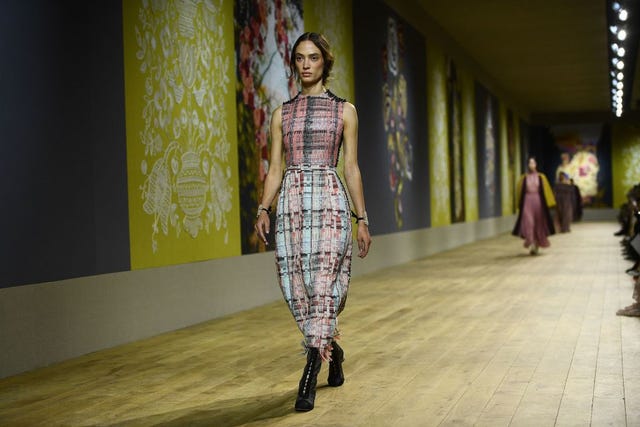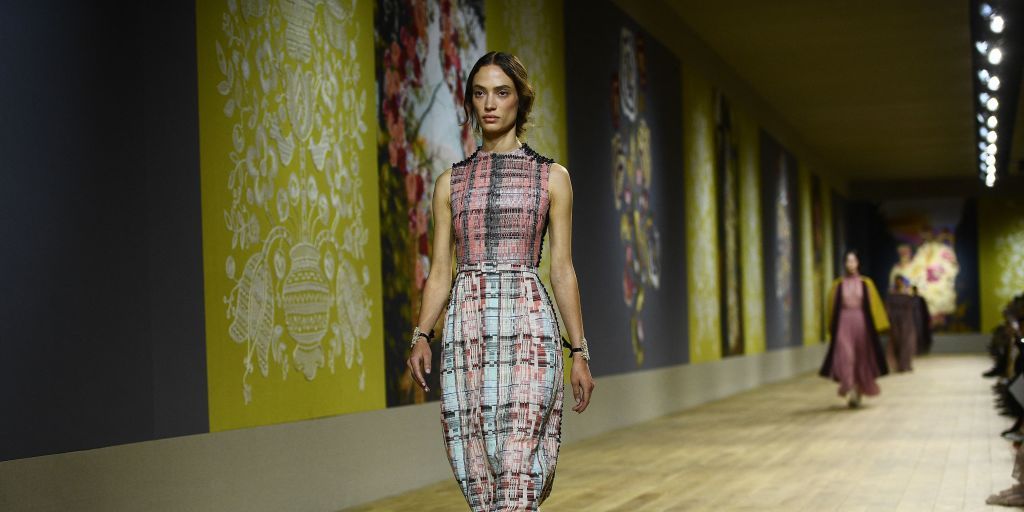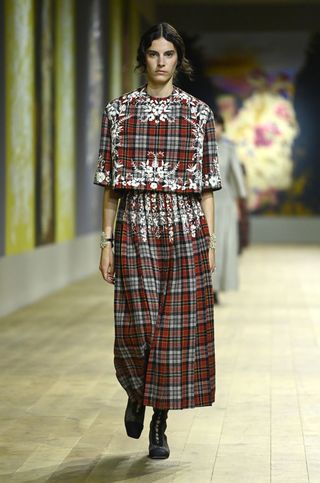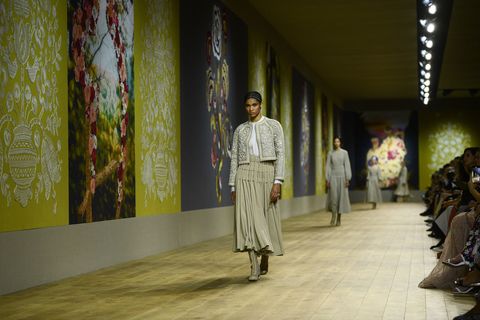
Christophe ArchambaultGetty Images
It’s a strange time to be in fashion; not just to write about it and consume it, but also to create it. Even the mind-blowing artistry of a haute couture show, where one-of-a-kind garments are sewn together by practiced hands with millions of tiny stitches, can only temporarily distract from the world’s ever-unfurling horrors. Beauty can be hard to recognize against a backdrop of such ugliness. It’s within this set of contradictions that Dior’s folkloric autumn/winter 2022 couture collection was born.
The pieces sent down the runway in Paris, notably on the Fourth of July, were romantic and dreamy, yet structured and decidedly traditional. Neutrals dominated the color palette, punctuated by the occasional hits of black, navy, and chartreuse. Rich embroidery acted as the star of the show, with intricately designed floral motifs appearing on everything from wool crepe to silk and cashmere.
Of note: a tartan co-ord set with hand-stitched detail, a gauzy floor-grazing maxi cinched at the waist, and a mid-length dresses with a Mao collar reminiscent of those worn to celebrate Chinese New Year. Tradition, as it relates to why and how we dress, was a prominent theme throughout, with garments paying sartorial tribute to different countries and cultures, the underlying message being that we all belong together. Models wore long, loose braids down their backs and barely-there makeup—little more than a touch of pink blush was visible—to keep the emphasis on the clothes.
It’s a collection made by and for women, with Maria Grazia Chiuri as the storied creative director of the house—the first woman to hold the role. It’s also a collection inspired by one woman in particular, or at least her work: Olesia Trofymenko, the Ukrainian artist whose depictions of the tree of life were the starting point for the designs, celebrating our deep connections to ancestry, as well as strength and wisdom. Chiuri invited Trofymenko to design the show’s set, and the life-size tapestries featuring hand-embroidered flowers did not disappoint. Each one was painstakingly handmade by women at the Chanakya School of Craft in Mumbai, which partnered with Dior for the upcoming season.
“This is a matter of shaping materials and forms in the space for reflection that the atelier represents, permeable to the social reality in which we live; a matter of recalling what it means to be human today,” the house said in a press release. “Gestures passed on, learned and always perfectible, are repeated. The tree of life is a call, a warning, to make traditions and gestures shine through, allowing us to recover a balance, if only momentarily.”
Chiuri echoed this sentiment when we spoke to her backstage after the show. She is perhaps the most powerful and outspoken capital-F feminist in fashion, so we were of course curious what she made of the recent U.S. Supreme Court decision to overturn Roe v. Wade.
“We are super worried because the USA represents freedom and human rights, so we are really worried in Europe,” she said. “We look around us at what’s happened and we are super scared and we want to fight for it, because we believe in human rights. I think fashion has the opportunity to build a bridge between different communities and different voices. We also have a platform, so we try to use our voice to say that these values are super important for everybody around the world.”
Wearing a white T-shirt emblazoned with the message “We Should All Be Feminists,” which originally debuted in her 2017 collection for Dior, Chiuri also spoke about the importance of staying optimistic in dark times.
“I think that all the collections, in some ways, represent the moment we are living [in],” she said. “We are living the moment where we want to be optimists, but sometimes, we are negative. [Dior is] a global brand, our stuff is super huge, we have a lot of young people that are really fragile in this moment. So I think that we have to be optimistic, but at the same time, we have to try to make something, probably a little step, that gives the people the optimistic idea that we can do something. Because that’s the thing: we are not to become depressed, because the risk is also that around the world.”
And that’s exactly what Chiuri’s show did. By celebrating humanity and craftsmanship, the collection helped restore a sense of optimism—even if only temporarily.
This content is created and maintained by a third party, and imported onto this page to help users provide their email addresses. You may be able to find more information about this and similar content at piano.io


